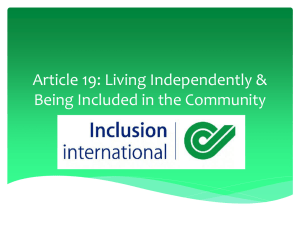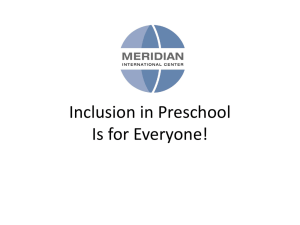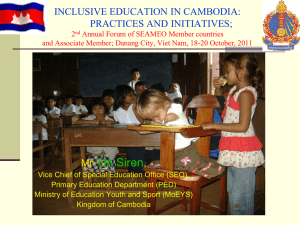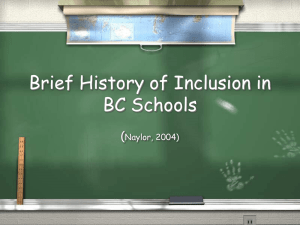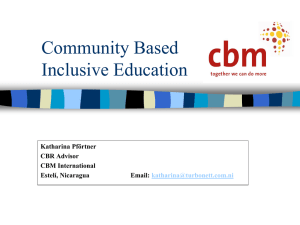Default Normal Template
advertisement
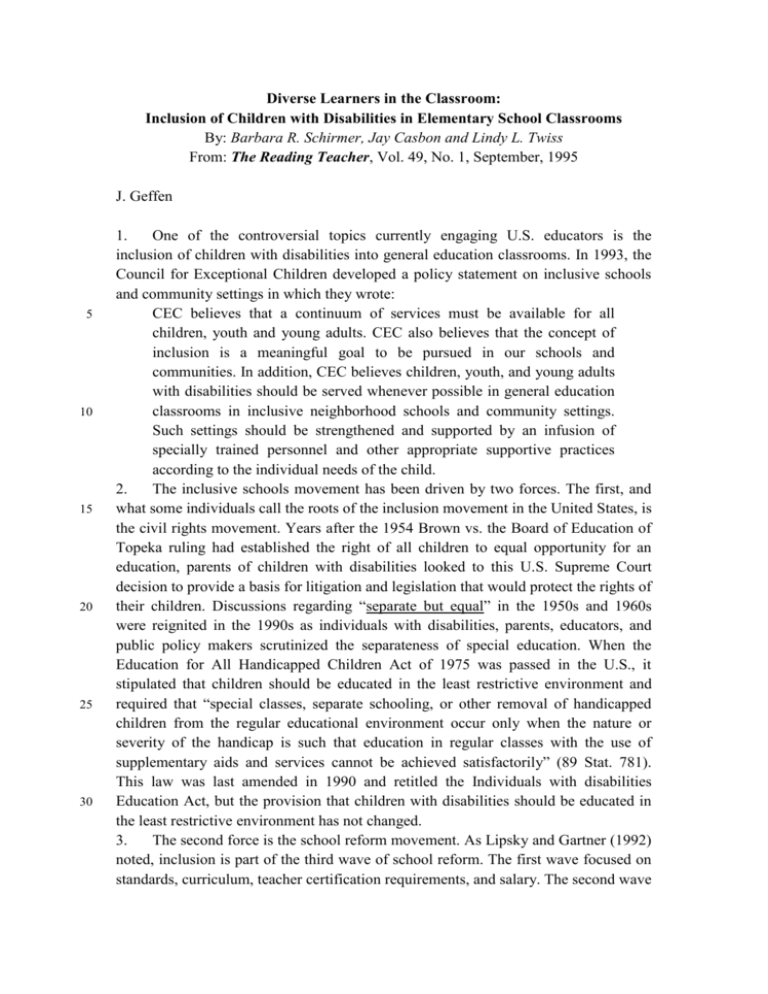
Diverse Learners in the Classroom: Inclusion of Children with Disabilities in Elementary School Classrooms By: Barbara R. Schirmer, Jay Casbon and Lindy L. Twiss From: The Reading Teacher, Vol. 49, No. 1, September, 1995 J. Geffen 5 10 15 20 25 30 1. One of the controversial topics currently engaging U.S. educators is the inclusion of children with disabilities into general education classrooms. In 1993, the Council for Exceptional Children developed a policy statement on inclusive schools and community settings in which they wrote: CEC believes that a continuum of services must be available for all children, youth and young adults. CEC also believes that the concept of inclusion is a meaningful goal to be pursued in our schools and communities. In addition, CEC believes children, youth, and young adults with disabilities should be served whenever possible in general education classrooms in inclusive neighborhood schools and community settings. Such settings should be strengthened and supported by an infusion of specially trained personnel and other appropriate supportive practices according to the individual needs of the child. 2. The inclusive schools movement has been driven by two forces. The first, and what some individuals call the roots of the inclusion movement in the United States, is the civil rights movement. Years after the 1954 Brown vs. the Board of Education of Topeka ruling had established the right of all children to equal opportunity for an education, parents of children with disabilities looked to this U.S. Supreme Court decision to provide a basis for litigation and legislation that would protect the rights of their children. Discussions regarding “separate but equal” in the 1950s and 1960s were reignited in the 1990s as individuals with disabilities, parents, educators, and public policy makers scrutinized the separateness of special education. When the Education for All Handicapped Children Act of 1975 was passed in the U.S., it stipulated that children should be educated in the least restrictive environment and required that “special classes, separate schooling, or other removal of handicapped children from the regular educational environment occur only when the nature or severity of the handicap is such that education in regular classes with the use of supplementary aids and services cannot be achieved satisfactorily” (89 Stat. 781). This law was last amended in 1990 and retitled the Individuals with disabilities Education Act, but the provision that children with disabilities should be educated in the least restrictive environment has not changed. 3. The second force is the school reform movement. As Lipsky and Gartner (1992) noted, inclusion is part of the third wave of school reform. The first wave focused on standards, curriculum, teacher certification requirements, and salary. The second wave Diverse Learners in the Classroom / 2 35 40 45 50 55 60 65 70 75 focused on teacher empowerment, school-based management, and parental choice. And the third wave focuses on the student: Giving students respect, building upon their knowledge, providing them control over the learning process and appropriate materials, helping them to see the connection between subjects, encouraging cooperation among students – these are the necessary predicates to increases in student learning, the bases for student improvement (p. 5). 4. Both of these forces have led advocates of full inclusion to believe that children with disabilities should be educated in general education classrooms in neighborhood schools. They argue that not only are these classrooms the least restrictive environment for children with disabilities, but also that inclusive schools will raise standards, increase student achievement, enhance positive self-identity, encourage strong social relationships, and enable students to develop the knowledge and skills to become lifelong independent learners. Advocates believe that inclusive schools benefit all children because they do not emphasize disability or inability; they focus on ability. 5. Although this stance has ignited passionate argument, U.S. school districts have not waited for educators to resolve the debate. Instead, educators have begun to look to the neighborhood school as the first option for the child with a disability and to consider other educational placements only in light of compelling evidence that the child cannot succeed in the general education classroom with age-appropriate peers, even if given substantial support. 6. As children with disabilities enter general education classrooms, classroom teachers are asking for help in developing models, strategies, and techniques that will enable all of their students to be successful learners. We looked at one group of special education students in a public elementary school to see what the challenges are, what types of help their teachers are being given, and how well the goals of inclusion are being met. One School 7. In the school we visited, 31 fifth- and sixth-grade students, 10 through 12 years of age, qualify for special education because of health impairment, hearing impairment, learning disability, behavior disorder, fetal alcohol syndrome, or attention deficit with hyper-activity disorder. These 31 students receive help from one special education teacher for 40 minutes to 3 hours daily, depending on their individualized education plans, and they spend the remainder of the school day in their regular classrooms. When the special education students are in the regular classrooms, class sizes number between 30 and 32. In addition to the direct teaching provided by the special and regular education teachers, an educational specialist has responsibility for assisting with curriculum development and modification, classroom schedules, behavior management systems, monitoring student progress, data-collection systems, ordering materials, and parent communication. Diverse Learners in the Classroom / 3 80 85 90 95 100 105 110 115 8. The regular classroom teachers report that their greatest challenge is providing appropriate literacy instruction to those children whose reading and writing abilities may be as many as 5 years below grade level. Teachers also recognize that the children’s special physical, emotional, social, learning, and communication needs make it necessary to seek ways to modify the strategies they use. For example, most of these teachers are whole language enthusiasts, believing deeply that the focus of literacy instruction should always be on the meaningful use of language in authentic context, children should be given choice and ownership, and processes should be emphasized over products. Yet the strategies that reflect these beliefs have not always been successful with individual children. 9. As a team, these teachers have developed workable short-term strategies, are considering a variety of long-term strategies, and are open to promising ideas. Each strategy is measured against the goals of inclusion by asking the following questions: 1. Does this strategy enhance the children’s self-identity and encourage positive social relationships? 2. Is this strategy based on high expectations and will it result in high achievement? 3. Does this strategy encourage the children to be autonomous learners? 10. Short-term strategies: A workable compromise. Currently, the special education teacher uses a pull-out model for literacy instruction. She is using a highly structured, direct instruction model for reading, incorporating some basic materials and some trade books. This seems to contradict her whole language philosophy, but she has found that attention to skills, frequent and positive reinforcement, and the way that the children’s attention is held throughout instruction have had an extremely positive effect on the children’s reading achievement. And because the children see themselves as successful readers, she has found that their self-concepts have improved. 11. Writing instruction is often based on the use of imagery. The children lie on the floor and close their eyes, except for the children who are deaf, and the teacher tells an imagery-evoking story starter. She has found that the imagery and relaxation are critical for breaking through the negative feelings that most of her students have about writing. Her students also write in dialogue journals daily and participate in sustained silent reading in their regular classrooms. 12. These strategies for developing literacy are working well for the short term, but the teachers would like to encourage more collaborative learning with children in the regular education classrooms in order to develop greater independence and selfmotivation. 13. Long-term strategies: Workable possibilities. The highest priority for the teachers is to be able to team teach. The special education teacher would like to spend time in each regular classroom during the school day team teaching with the regular teachers, trying out instructional strategies, working with individual special education students, and adapting materials and curriculum. During this time, she could also help Diverse Learners in the Classroom / 4 120 125 130 135 140 145 150 155 the classroom teacher conceptualize her learning goals in ways that would allow for different levels of attainment and different degrees of emphasis for each child. 14. Teachers want to try cooperative learning and peer tutoring in the inclusive classrooms. These models have worked effectively with the regular education students, but the low reading levels of many of the special education students have made teachers reluctant to try these models with heterogeneous groups or pairings of special education and regular education students. Teachers fear that the special education students will always be on the receiving end of information and will never be the experts or teachers within their groups. Teachers are seeking ways to provide different levels of reading materials on the same topic, assign roles that take into account individual abilities, and provide multiple ways for students to contribute, such as through art or music. The teachers would also like to try strategies such as Reciprocal Teaching (Palincsar & Brown, 1986; Moore, 1988) and K-W-L (Ogie, 1986), which have been successful with both regular education students and students with reading difficulties. 15. Promising Ideas. Many of the most promising approaches for developing literacy in children with disabilities require one-to-one tutoring and are geared for the young reader. It is difficult for teachers with 30 or more students in their classrooms (a) to figure out how to implement a strategy that is as labor intensive as tutoring and (b) to justify a strategy that segregates students from one another. 16. One approach that keeps all students together for literacy instruction is a modification of the CIRC (Cooperative Integrated Reading and Composition) method (Jenkins et al., 1994). In this approach, reading ability groups are eliminated; all elementary students receive reading and language arts instruction within their regular classrooms; and individual needs are met through peer and cross-age tutoring, supplemental instruction for students who are having extreme difficulty with decoding, and in-class instructional support from specialists. Jenkins et al. (1994) found positive effects on reading vocabulary, total reading, and language scores for the regular, remedial, and special education students in Grades 1 through 6. The Future of Inclusion 17. It is not yet clear how many local educational agencies have adopted a full inclusion model for educating students with disabilities. States and local school districts that rarely use separate facilities for educating students with disabilities have “a systemic commitment to directing significant special education resources toward enabling more students with disabilities to be appropriately served in general education settings” (Hasazi, Johnston, Liggett & Schattman, 1994, p. 496). These schools look like the inclusive schools described by Schrag and Burnette (1994), where “students work in more flexible learning environments, with flexible curricula and instruction that are accessible to all” (p. 64). 18. Inclusion is based on the understanding that both special education teachers and general education teachers have expertise about models and theories, characteristics of Diverse Learners in the Classroom / 5 learners, assessment, learning styles, learning environments, strategies and techniques, curriculum, classroom management, and child development. By combining their 160 knowledge and talents, they can develop strategies that focus less on matching the child’s disability to the teaching method and more on methods that are effective with all children. References Council for Exceptional Children Delegate Assembly. (1993). CEC policy on 165 inclusive schools and community settings. Reston, VA: The Council for Exceptional Children. Education for All Handicapped Children Act of 1975, Pub. L. No. 94-142, Sec. 612, 89 Stat. 781 (1975). Hasazi, S.B., Johnston, A.P., Liggett, A.M., & Schattman, R.A. (1994). A qualitative 170 policy study of the least restrictive environment provision of the Individuals with Disabilities Education Act, Exceptional Children, 60, 491-507. Jenkins, J.R., Jewell, M., Leicester, N., O’Connor, R.E., Jenkins, L.M., & Troutner, N.M. (1994). Accommodations for individual differences without classroom ability groups: An experiment in school restructuring, Exceptional Children, 60, 175 344-358. Lipsky, D.K. & Gartner, A. (1992). Achieving full inclusion: Placing the student at the center of school reform. In W. Stainback and S. Stainback (Eds.), Controversial issues confronting special education. Divergent perspectives (pp. 3-12), Boston: Allyn & Bacon. 180 Moore, P.J. (1988). Reciprocal teaching and reading comprehension: A review. Journal of Research in Reading, 11, 3-14. Ogie, D.M. (1986). K-W-L: A teaching model that develops active reading of expository text. The Reading Teacher, 39, 564-570. Palincsar, A. & Brown, A.L. (1986). Inter-active teaching to promote independence 185 learning from text. The Reaching Teacher, 39, 771-777. Schrag, J. & Burnette, J. (1994). Inclusive schools. Teaching Exceptional Children, 26, 64-68. Diverse Learners in the Classroom / 6 Questions should be answered in your own words, in English, unless otherwise indicated. 1. Answer the question below in English. What issue has recently preoccupied American educators? Answer : ____________________________________________________________ Answer the question below in Hebrew. 2. What social and political developments – paragraph 2 – have provided the impetus to the movement for the full inclusion of children with learning disabilities? Substantiate your answer. Answer : ____________________________________________________________ 3. Answer the question below in English. In what way is the slogan separate but equal – which was raised in the 1950s and 1960s by those who opposed the integration of Black students in the Southern educational institutions – relevant to the ongoing controversy concerning the inclusion of children with learning disabilities (paragraph 2)? Explain the analogy. Answer : ____________________________________________________________ Answer the question below in Hebrew. 4. What are the underlying assumptions – paragraph 3 – that might warrant the inclusion of children with learning disabilities in regular classrooms? Answer : ____________________________________________________________ 5. What steps have the local educational authorities in the U.S. recently taken in this field? Answer : ____________________________________________________________ Diverse Learners in the Classroom / 7 6. Answer the question below in English. How are the needs of the children with learning disabilities in the school in question – paragraph 7 – taken care of on the practical level? Answer : ____________________________________________________________ Answer the question below in Hebrew. 7. Why is the whole language approach, namely the attempt to teach language and new vocabulary in a general context – paragraph 8 – likely to be problematic in the case of children with learning disabilities? The answer is not stated; it must be inferred. Answer : ____________________________________________________________ 8. 9. Answer the question below in English. How are peer tutoring and cooperative learning – paragraph 14 – in an inclusive classroom, likely to affect the self-image of the learning disabled? Answer : ____________________________________________________________ How are financial considerations likely to affect – paragraph 15 – the prospects of inclusive classrooms? Answer : ____________________________________________________________ Answer the question below in Hebrew. 10. What are the prerequisites – paragraph 18 – upon whose fulfilment hinges the outcome of all the work done in the inclusive classes? Answer : ____________________________________________________________ Diverse Learners in the Classroom / 8

